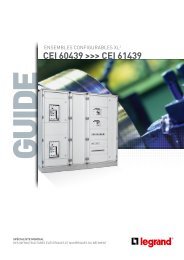Download - legrand
Download - legrand
Download - legrand
You also want an ePaper? Increase the reach of your titles
YUMPU automatically turns print PDFs into web optimized ePapers that Google loves.
Electrical characteristics of medium voltage<br />
capacitors (continued)<br />
PROTECTION DEVICES FOR "ALL-FILM" MV CAPACITORS<br />
MEDIUM VOLTAGE RANGE<br />
Protection using internal fuses<br />
Due to the advantages they provide, internal fuses are<br />
the most frequently used means of protecting "all-film"<br />
MV capacitors.<br />
In this technology, each elementary capacitance<br />
forming the capacitor is protected by its own<br />
internal fuse.<br />
When there is a fault on an elementary capacitance,<br />
the internal fuse eliminates the corresponding<br />
capacitance and the continuity of service of the<br />
capacitor is assured.<br />
Given the large number of elementary capacitances<br />
that make up the device, the loss of power resulting<br />
from the first fault is negligible (less than 2%). The<br />
external unbalance protection will only be activated if<br />
there is a large number of "broken down" elementary<br />
capacitances in one capacitor which will create an<br />
unbalance. The operation of an internal fuse is activated:<br />
- When the voltage of the capacitor reaches its<br />
maximum value, and therefore the current reaches<br />
its minimum value, the voltage difference at the<br />
terminals of the "faulty" elementary capacitance<br />
will trigger the blow-out of the corresponding fuse.<br />
- When the current reaches it maximum value,<br />
and therefore the voltage reaches its minimum<br />
value, the flow of the energy stored in the parallel<br />
operational capacitances in the "faulty" capacitance<br />
will trigger the blow-out of the corresponding fuse.<br />
2<br />
3<br />
1<br />
Internal view of an "all-film" MV<br />
capacitor with internal fuses<br />
1. Discharge resistor<br />
2. Internal fuse<br />
3. Elementary capacitance<br />
56

















